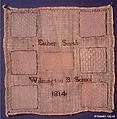Darning sampler
Esther Smith American
Not on view
Esther Smith made this fine darning sampler at the Wilmington Boarding School, one of Delaware’s most successful early nineteenth century girls’ boarding schools. Founded by Quakers Joshua Maule and Eli Hilles, the school was nonsectarian and admitted girls for three months or more with a capacity of up to 50 students at a time. In addition to academic subjects, the school advertised that "proper attention will also be paid to instruct the girls in plain Needlework."
Darning was a needlework skill used for repairing textiles to extend their usefulness, since textiles were among the most precious of household items in the pre-industrial era. Each of the darning blocks in Esther’s sampler represents a different weave pattern to repair worn places and holes in clothing and household linens such as towels, table clothes, and napkins. In a tremendously intricate exercise, the patterns of different woven fabrics were replicated following a prescribed needle weaving process that resulted in a nearly invisible mend to the original textiles. Esther’s delicate darns include a herringbone mend and several repeating diaper pattern mends, using cotton, wool and silk threads on a linen ground. At center, she had completed a mend that looks like it was meant for repairing wool stockings. Unique to the early known Wilmington School darning samplers, Esther stitched black lines around the seven mending blocks and added a zig-zag border.
The earliest known darning samplers have roots in eighteenth century German-speaking Europe and spread to Northern Europe and England by the end of the century. During the opening decades of the nineteenth century American Quaker schools like Westtown in West Chester, Pennsylvania, required their girl students to master darning techniques. Several of the needlework teachers at the Wilmington Boarding School had taught at Westtown, and the darning samplers from both schools share similarities in design and patterns. All the known darning samplers from both schools have a central inscription of the name of the maker, her school, and the date in the middle of the sampler.
Due to rights restrictions, this image cannot be enlarged, viewed at full screen, or downloaded.
This artwork is meant to be viewed from right to left. Scroll left to view more.



